PSY 300 Final Project: Research Investigation on Brain and Behavior
VerifiedAdded on 2023/05/27
|10
|2385
|319
Report
AI Summary
This research investigation, conducted for a PSY 300 final project, explores the biological influences on behavior, specifically focusing on the brain and behavior relationship. The student identifies a research gap concerning the impact of addiction on personality, particularly among adolescents. The report includes a literature review of relevant articles, exploring topics such as brain development, the role of the hippocampus and amygdala, and the effects of addiction on the brain. The student proposes a qualitative research design using case studies and focus groups to investigate how adolescents interpret drug abuse preferences and their impact on behavioral responses. Ethical considerations, including informed consent and participant protection, are also addressed. The study aims to analyze themes related to drug abuse, peer influence, and behavioral changes, contributing to a deeper understanding of the complex relationship between biology and behavior, especially in the context of addiction.

Running Head: RESEARCH INVESTIGATION 1
Research Investigation
Name
PSY 300
Professor
Institution
Date
Research Investigation
Name
PSY 300
Professor
Institution
Date
Paraphrase This Document
Need a fresh take? Get an instant paraphrase of this document with our AI Paraphraser

Running Head: RESEARCH INVESTIGATION 2
The focus of my research design for my final project is biological influences behavior
with the topic brain and behavior. I reviewed 5 articles to support this topic, three that were
provided to me and two that I chose on my own. My The research gap I have identified is
addiction and how it affects personality. The following information is my findings within the
articles and the research gap that I have found followed by my design.
Literature Reviews
According to Südhof (2014) initial stages of brain development are dynamic in the usual
maturation, as genetic mutations bring about defects and distortion of neurotransmitters are
responsible for the onset of learning disabilities and impairment and learning disabilities. The
central and peripheral nervous systems work together for controlling the control bodily actions,
such as, voice control and laughing. Evidences have also suggested that the hippocampus plays
an important role in memory formation, specifically long-term memory (Jutras, Fries & Buffalo,
2013). It has also been mentioned by Spiers and Barry (2015) that damage to hippocampus
produces strict and maladaptive behavior related to, decision-making, memory navigation,
exploration, imagination, social discourse and empathy. It has also been suggested that
amygdala, the part of the limbic system is greatly involved in emotional responses, of which fear
is a primary response. In other words, the amygdala is responsible for decoding emotions,
specifically those that are related to threatening stimuli.
Carver & McCarty, (2013) also suggested that addicts have been found to demonstrate
meaningfully low scores on self-concept subscale related to 'social resonance,' which is
concomitant with an increased brain activation in the left angular gyrus. The researcher also
stated that greater accomplishment with older stage and pubertal period in abstraction, emotion,
The focus of my research design for my final project is biological influences behavior
with the topic brain and behavior. I reviewed 5 articles to support this topic, three that were
provided to me and two that I chose on my own. My The research gap I have identified is
addiction and how it affects personality. The following information is my findings within the
articles and the research gap that I have found followed by my design.
Literature Reviews
According to Südhof (2014) initial stages of brain development are dynamic in the usual
maturation, as genetic mutations bring about defects and distortion of neurotransmitters are
responsible for the onset of learning disabilities and impairment and learning disabilities. The
central and peripheral nervous systems work together for controlling the control bodily actions,
such as, voice control and laughing. Evidences have also suggested that the hippocampus plays
an important role in memory formation, specifically long-term memory (Jutras, Fries & Buffalo,
2013). It has also been mentioned by Spiers and Barry (2015) that damage to hippocampus
produces strict and maladaptive behavior related to, decision-making, memory navigation,
exploration, imagination, social discourse and empathy. It has also been suggested that
amygdala, the part of the limbic system is greatly involved in emotional responses, of which fear
is a primary response. In other words, the amygdala is responsible for decoding emotions,
specifically those that are related to threatening stimuli.
Carver & McCarty, (2013) also suggested that addicts have been found to demonstrate
meaningfully low scores on self-concept subscale related to 'social resonance,' which is
concomitant with an increased brain activation in the left angular gyrus. The researcher also
stated that greater accomplishment with older stage and pubertal period in abstraction, emotion,
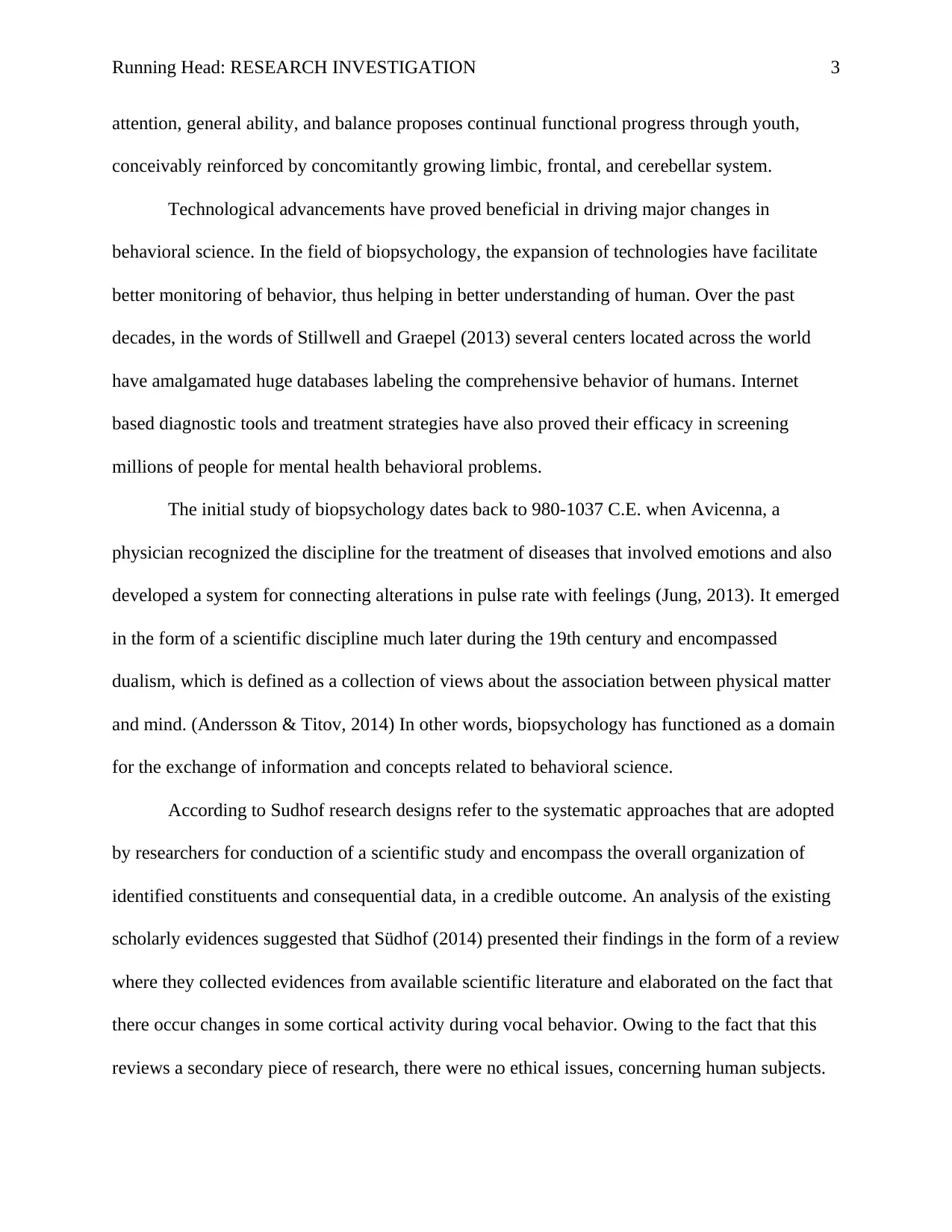
Running Head: RESEARCH INVESTIGATION 3
attention, general ability, and balance proposes continual functional progress through youth,
conceivably reinforced by concomitantly growing limbic, frontal, and cerebellar system.
Technological advancements have proved beneficial in driving major changes in
behavioral science. In the field of biopsychology, the expansion of technologies have facilitate
better monitoring of behavior, thus helping in better understanding of human. Over the past
decades, in the words of Stillwell and Graepel (2013) several centers located across the world
have amalgamated huge databases labeling the comprehensive behavior of humans. Internet
based diagnostic tools and treatment strategies have also proved their efficacy in screening
millions of people for mental health behavioral problems.
The initial study of biopsychology dates back to 980-1037 C.E. when Avicenna, a
physician recognized the discipline for the treatment of diseases that involved emotions and also
developed a system for connecting alterations in pulse rate with feelings (Jung, 2013). It emerged
in the form of a scientific discipline much later during the 19th century and encompassed
dualism, which is defined as a collection of views about the association between physical matter
and mind. (Andersson & Titov, 2014) In other words, biopsychology has functioned as a domain
for the exchange of information and concepts related to behavioral science.
According to Sudhof research designs refer to the systematic approaches that are adopted
by researchers for conduction of a scientific study and encompass the overall organization of
identified constituents and consequential data, in a credible outcome. An analysis of the existing
scholarly evidences suggested that Südhof (2014) presented their findings in the form of a review
where they collected evidences from available scientific literature and elaborated on the fact that
there occur changes in some cortical activity during vocal behavior. Owing to the fact that this
reviews a secondary piece of research, there were no ethical issues, concerning human subjects.
attention, general ability, and balance proposes continual functional progress through youth,
conceivably reinforced by concomitantly growing limbic, frontal, and cerebellar system.
Technological advancements have proved beneficial in driving major changes in
behavioral science. In the field of biopsychology, the expansion of technologies have facilitate
better monitoring of behavior, thus helping in better understanding of human. Over the past
decades, in the words of Stillwell and Graepel (2013) several centers located across the world
have amalgamated huge databases labeling the comprehensive behavior of humans. Internet
based diagnostic tools and treatment strategies have also proved their efficacy in screening
millions of people for mental health behavioral problems.
The initial study of biopsychology dates back to 980-1037 C.E. when Avicenna, a
physician recognized the discipline for the treatment of diseases that involved emotions and also
developed a system for connecting alterations in pulse rate with feelings (Jung, 2013). It emerged
in the form of a scientific discipline much later during the 19th century and encompassed
dualism, which is defined as a collection of views about the association between physical matter
and mind. (Andersson & Titov, 2014) In other words, biopsychology has functioned as a domain
for the exchange of information and concepts related to behavioral science.
According to Sudhof research designs refer to the systematic approaches that are adopted
by researchers for conduction of a scientific study and encompass the overall organization of
identified constituents and consequential data, in a credible outcome. An analysis of the existing
scholarly evidences suggested that Südhof (2014) presented their findings in the form of a review
where they collected evidences from available scientific literature and elaborated on the fact that
there occur changes in some cortical activity during vocal behavior. Owing to the fact that this
reviews a secondary piece of research, there were no ethical issues, concerning human subjects.
⊘ This is a preview!⊘
Do you want full access?
Subscribe today to unlock all pages.

Trusted by 1+ million students worldwide

Running Head: RESEARCH INVESTIGATION 4
However, the study by Jutras, Fries and Buffalo (2013) involved a primary research where
hippocampal activity measurement in rhesus monkeys formed the foundation of the research
design. The researchers investigated the role of hippocampus in memory formation and visual
activity by exposing the research subjects to 200 novel complex stimuli. The research design
comprised of neuroimaging and behavioral testing with the use of 3-T Siemens magnetic
resonance imaging scanner, among community recruited juveniles. Prior approval was taken
from the institutional review board for the research design (Lozier, Cardinale, VanMeter &
Marsh, 2014). In contrast, Carver and McCarty (2013) adopted a cohort research design, based
on results of Experian Marketing Services’ Simmonsw National Consumer Study (NCS). This
study also did not take into consideration any ethical issues of research. Certain ethical issues
that should be taken into consideration while conducting biopsychological research encompass
informed consent, debriefing, participant protection, confidentiality, deception, and withdrawal
from research (Fromm, 2013).
Outlining the participants on the research and obtaining consent has been considered
imperative since several decades. Providing the participants a general idea of the investigation,
their reason for participation, and clarification is also considered vital in research. Over the
years, it has been stated time and gain that the researchers must ensure preventing distress to
research participants, by protecting them from mental and physical harm. Misleading or wrongly
informing participants about the objectives and purpose of the research is another major aspect
(Salman, Ngueng Feze & Joly, 2016).
Gap and Research Design
I truly believe our behavior plays the biggest roles in our personalities and the research
gap I found within the articles that need to be explored is drug abuse preference related behavior
However, the study by Jutras, Fries and Buffalo (2013) involved a primary research where
hippocampal activity measurement in rhesus monkeys formed the foundation of the research
design. The researchers investigated the role of hippocampus in memory formation and visual
activity by exposing the research subjects to 200 novel complex stimuli. The research design
comprised of neuroimaging and behavioral testing with the use of 3-T Siemens magnetic
resonance imaging scanner, among community recruited juveniles. Prior approval was taken
from the institutional review board for the research design (Lozier, Cardinale, VanMeter &
Marsh, 2014). In contrast, Carver and McCarty (2013) adopted a cohort research design, based
on results of Experian Marketing Services’ Simmonsw National Consumer Study (NCS). This
study also did not take into consideration any ethical issues of research. Certain ethical issues
that should be taken into consideration while conducting biopsychological research encompass
informed consent, debriefing, participant protection, confidentiality, deception, and withdrawal
from research (Fromm, 2013).
Outlining the participants on the research and obtaining consent has been considered
imperative since several decades. Providing the participants a general idea of the investigation,
their reason for participation, and clarification is also considered vital in research. Over the
years, it has been stated time and gain that the researchers must ensure preventing distress to
research participants, by protecting them from mental and physical harm. Misleading or wrongly
informing participants about the objectives and purpose of the research is another major aspect
(Salman, Ngueng Feze & Joly, 2016).
Gap and Research Design
I truly believe our behavior plays the biggest roles in our personalities and the research
gap I found within the articles that need to be explored is drug abuse preference related behavior
Paraphrase This Document
Need a fresh take? Get an instant paraphrase of this document with our AI Paraphraser
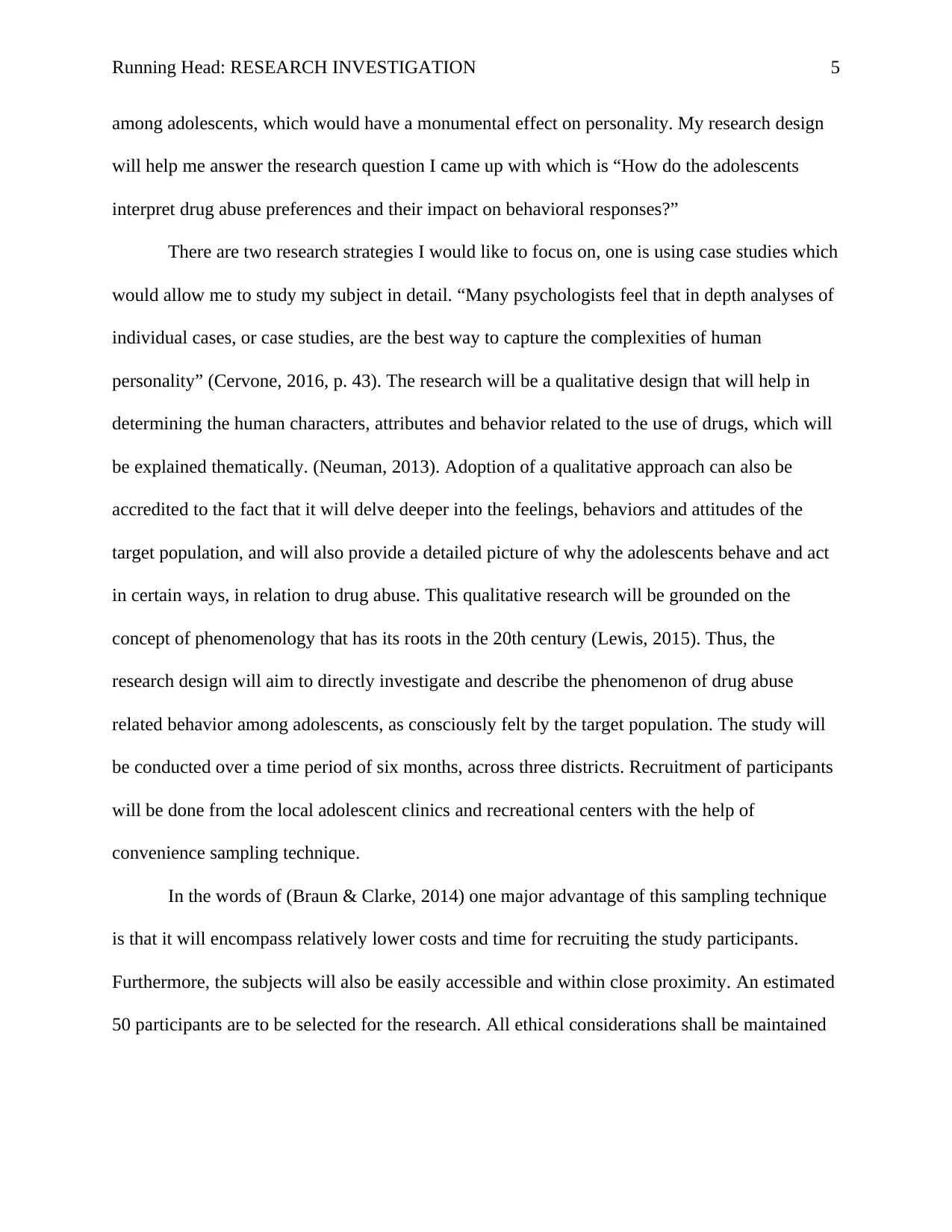
Running Head: RESEARCH INVESTIGATION 5
among adolescents, which would have a monumental effect on personality. My research design
will help me answer the research question I came up with which is “How do the adolescents
interpret drug abuse preferences and their impact on behavioral responses?”
There are two research strategies I would like to focus on, one is using case studies which
would allow me to study my subject in detail. “Many psychologists feel that in depth analyses of
individual cases, or case studies, are the best way to capture the complexities of human
personality” (Cervone, 2016, p. 43). The research will be a qualitative design that will help in
determining the human characters, attributes and behavior related to the use of drugs, which will
be explained thematically. (Neuman, 2013). Adoption of a qualitative approach can also be
accredited to the fact that it will delve deeper into the feelings, behaviors and attitudes of the
target population, and will also provide a detailed picture of why the adolescents behave and act
in certain ways, in relation to drug abuse. This qualitative research will be grounded on the
concept of phenomenology that has its roots in the 20th century (Lewis, 2015). Thus, the
research design will aim to directly investigate and describe the phenomenon of drug abuse
related behavior among adolescents, as consciously felt by the target population. The study will
be conducted over a time period of six months, across three districts. Recruitment of participants
will be done from the local adolescent clinics and recreational centers with the help of
convenience sampling technique.
In the words of (Braun & Clarke, 2014) one major advantage of this sampling technique
is that it will encompass relatively lower costs and time for recruiting the study participants.
Furthermore, the subjects will also be easily accessible and within close proximity. An estimated
50 participants are to be selected for the research. All ethical considerations shall be maintained
among adolescents, which would have a monumental effect on personality. My research design
will help me answer the research question I came up with which is “How do the adolescents
interpret drug abuse preferences and their impact on behavioral responses?”
There are two research strategies I would like to focus on, one is using case studies which
would allow me to study my subject in detail. “Many psychologists feel that in depth analyses of
individual cases, or case studies, are the best way to capture the complexities of human
personality” (Cervone, 2016, p. 43). The research will be a qualitative design that will help in
determining the human characters, attributes and behavior related to the use of drugs, which will
be explained thematically. (Neuman, 2013). Adoption of a qualitative approach can also be
accredited to the fact that it will delve deeper into the feelings, behaviors and attitudes of the
target population, and will also provide a detailed picture of why the adolescents behave and act
in certain ways, in relation to drug abuse. This qualitative research will be grounded on the
concept of phenomenology that has its roots in the 20th century (Lewis, 2015). Thus, the
research design will aim to directly investigate and describe the phenomenon of drug abuse
related behavior among adolescents, as consciously felt by the target population. The study will
be conducted over a time period of six months, across three districts. Recruitment of participants
will be done from the local adolescent clinics and recreational centers with the help of
convenience sampling technique.
In the words of (Braun & Clarke, 2014) one major advantage of this sampling technique
is that it will encompass relatively lower costs and time for recruiting the study participants.
Furthermore, the subjects will also be easily accessible and within close proximity. An estimated
50 participants are to be selected for the research. All ethical considerations shall be maintained
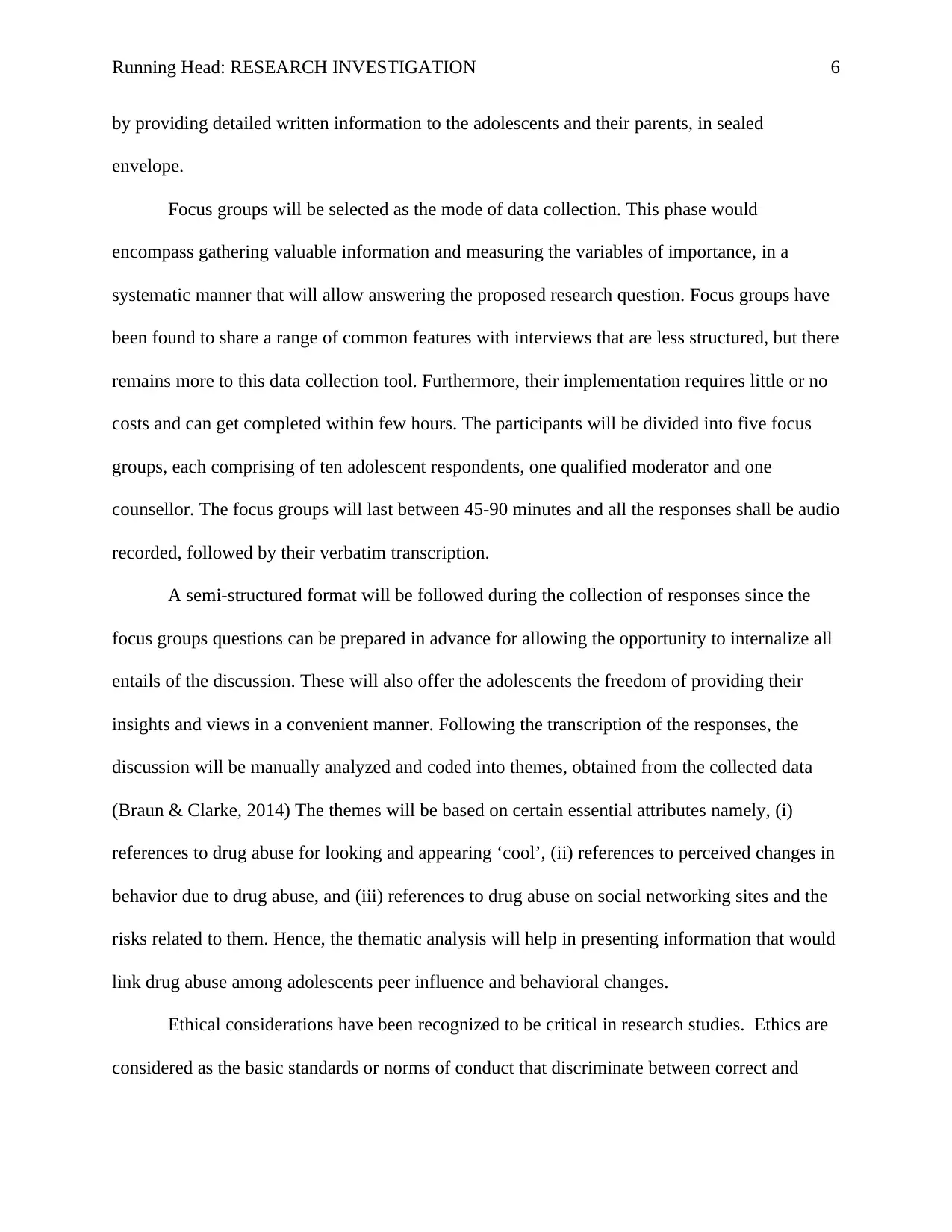
Running Head: RESEARCH INVESTIGATION 6
by providing detailed written information to the adolescents and their parents, in sealed
envelope.
Focus groups will be selected as the mode of data collection. This phase would
encompass gathering valuable information and measuring the variables of importance, in a
systematic manner that will allow answering the proposed research question. Focus groups have
been found to share a range of common features with interviews that are less structured, but there
remains more to this data collection tool. Furthermore, their implementation requires little or no
costs and can get completed within few hours. The participants will be divided into five focus
groups, each comprising of ten adolescent respondents, one qualified moderator and one
counsellor. The focus groups will last between 45-90 minutes and all the responses shall be audio
recorded, followed by their verbatim transcription.
A semi-structured format will be followed during the collection of responses since the
focus groups questions can be prepared in advance for allowing the opportunity to internalize all
entails of the discussion. These will also offer the adolescents the freedom of providing their
insights and views in a convenient manner. Following the transcription of the responses, the
discussion will be manually analyzed and coded into themes, obtained from the collected data
(Braun & Clarke, 2014) The themes will be based on certain essential attributes namely, (i)
references to drug abuse for looking and appearing ‘cool’, (ii) references to perceived changes in
behavior due to drug abuse, and (iii) references to drug abuse on social networking sites and the
risks related to them. Hence, the thematic analysis will help in presenting information that would
link drug abuse among adolescents peer influence and behavioral changes.
Ethical considerations have been recognized to be critical in research studies. Ethics are
considered as the basic standards or norms of conduct that discriminate between correct and
by providing detailed written information to the adolescents and their parents, in sealed
envelope.
Focus groups will be selected as the mode of data collection. This phase would
encompass gathering valuable information and measuring the variables of importance, in a
systematic manner that will allow answering the proposed research question. Focus groups have
been found to share a range of common features with interviews that are less structured, but there
remains more to this data collection tool. Furthermore, their implementation requires little or no
costs and can get completed within few hours. The participants will be divided into five focus
groups, each comprising of ten adolescent respondents, one qualified moderator and one
counsellor. The focus groups will last between 45-90 minutes and all the responses shall be audio
recorded, followed by their verbatim transcription.
A semi-structured format will be followed during the collection of responses since the
focus groups questions can be prepared in advance for allowing the opportunity to internalize all
entails of the discussion. These will also offer the adolescents the freedom of providing their
insights and views in a convenient manner. Following the transcription of the responses, the
discussion will be manually analyzed and coded into themes, obtained from the collected data
(Braun & Clarke, 2014) The themes will be based on certain essential attributes namely, (i)
references to drug abuse for looking and appearing ‘cool’, (ii) references to perceived changes in
behavior due to drug abuse, and (iii) references to drug abuse on social networking sites and the
risks related to them. Hence, the thematic analysis will help in presenting information that would
link drug abuse among adolescents peer influence and behavioral changes.
Ethical considerations have been recognized to be critical in research studies. Ethics are
considered as the basic standards or norms of conduct that discriminate between correct and
⊘ This is a preview!⊘
Do you want full access?
Subscribe today to unlock all pages.

Trusted by 1+ million students worldwide
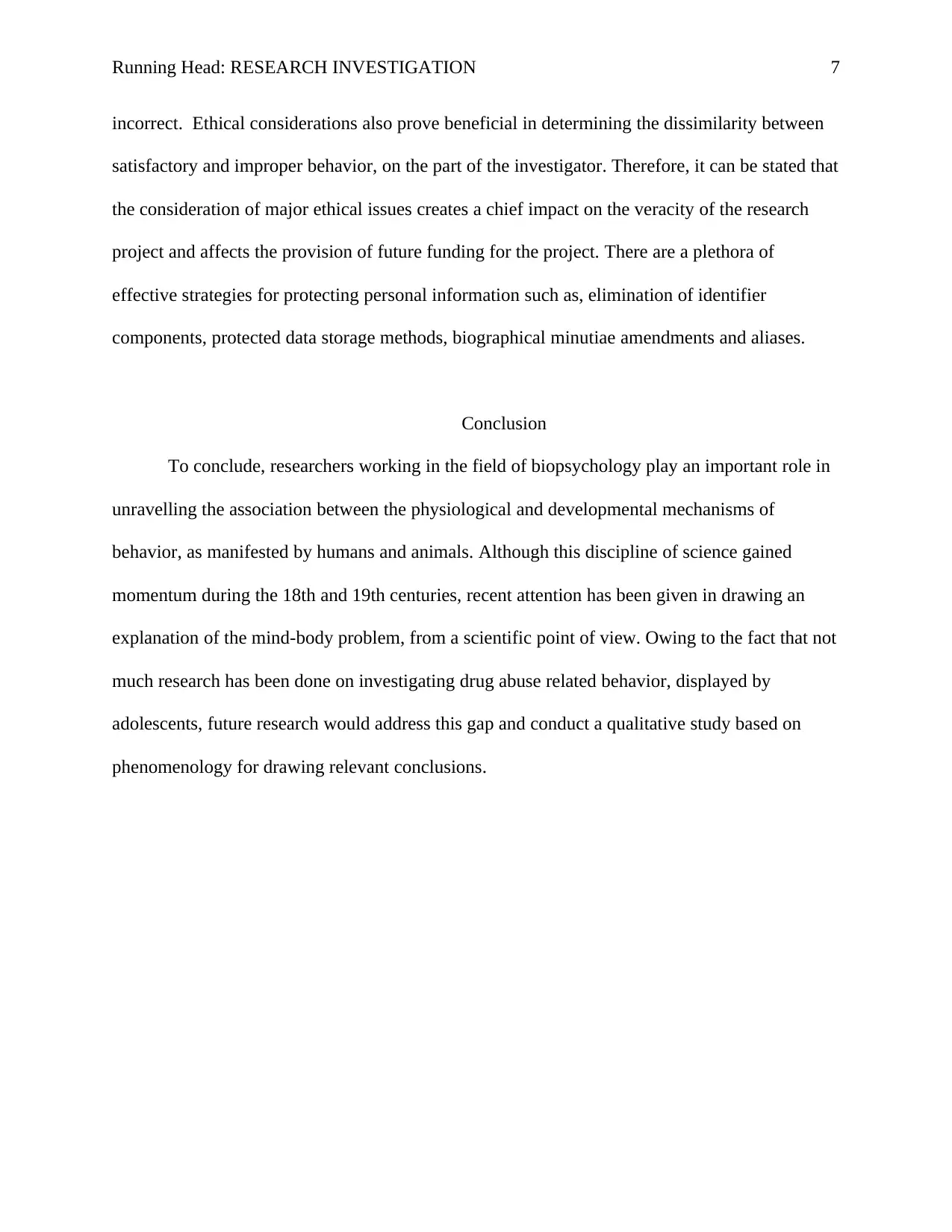
Running Head: RESEARCH INVESTIGATION 7
incorrect. Ethical considerations also prove beneficial in determining the dissimilarity between
satisfactory and improper behavior, on the part of the investigator. Therefore, it can be stated that
the consideration of major ethical issues creates a chief impact on the veracity of the research
project and affects the provision of future funding for the project. There are a plethora of
effective strategies for protecting personal information such as, elimination of identifier
components, protected data storage methods, biographical minutiae amendments and aliases.
Conclusion
To conclude, researchers working in the field of biopsychology play an important role in
unravelling the association between the physiological and developmental mechanisms of
behavior, as manifested by humans and animals. Although this discipline of science gained
momentum during the 18th and 19th centuries, recent attention has been given in drawing an
explanation of the mind-body problem, from a scientific point of view. Owing to the fact that not
much research has been done on investigating drug abuse related behavior, displayed by
adolescents, future research would address this gap and conduct a qualitative study based on
phenomenology for drawing relevant conclusions.
incorrect. Ethical considerations also prove beneficial in determining the dissimilarity between
satisfactory and improper behavior, on the part of the investigator. Therefore, it can be stated that
the consideration of major ethical issues creates a chief impact on the veracity of the research
project and affects the provision of future funding for the project. There are a plethora of
effective strategies for protecting personal information such as, elimination of identifier
components, protected data storage methods, biographical minutiae amendments and aliases.
Conclusion
To conclude, researchers working in the field of biopsychology play an important role in
unravelling the association between the physiological and developmental mechanisms of
behavior, as manifested by humans and animals. Although this discipline of science gained
momentum during the 18th and 19th centuries, recent attention has been given in drawing an
explanation of the mind-body problem, from a scientific point of view. Owing to the fact that not
much research has been done on investigating drug abuse related behavior, displayed by
adolescents, future research would address this gap and conduct a qualitative study based on
phenomenology for drawing relevant conclusions.
Paraphrase This Document
Need a fresh take? Get an instant paraphrase of this document with our AI Paraphraser
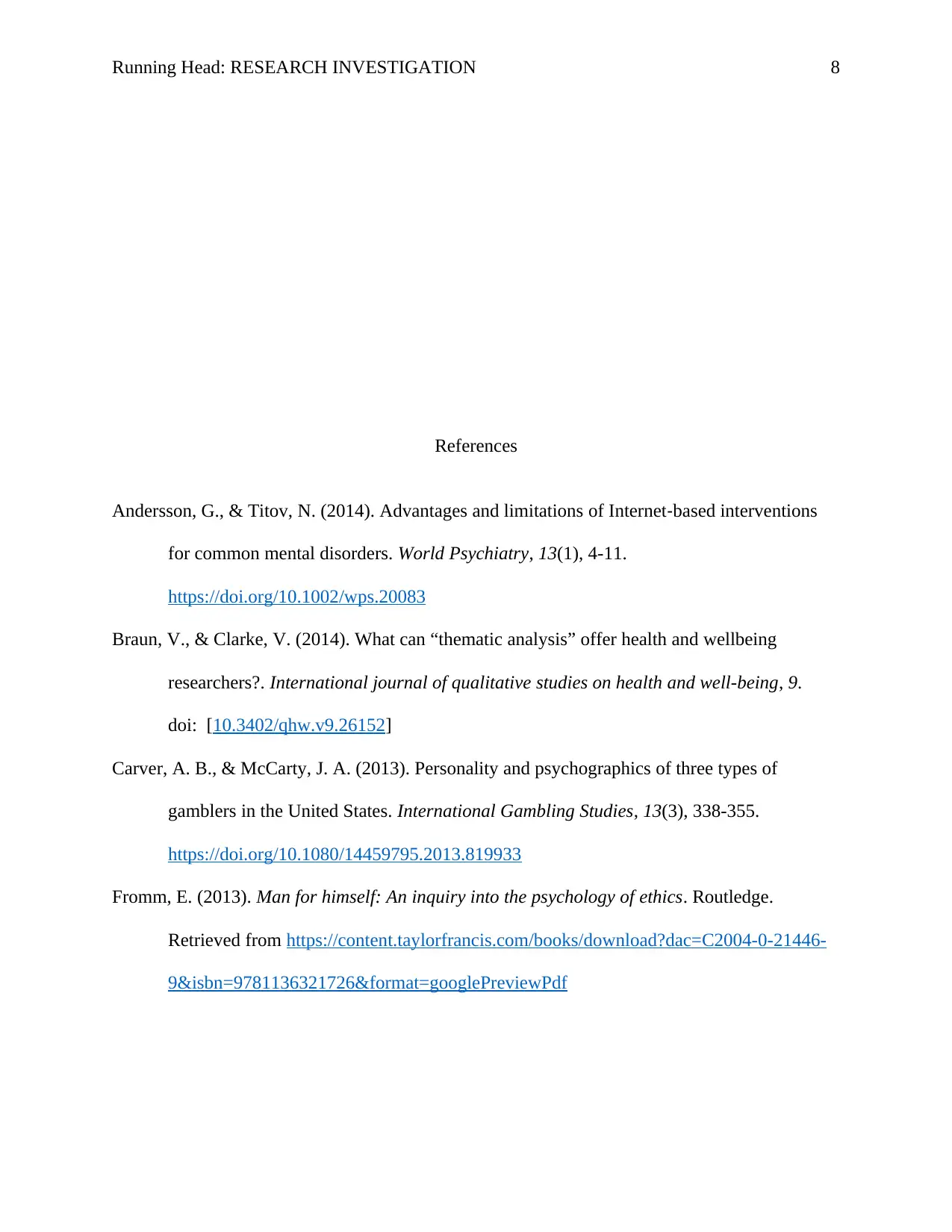
Running Head: RESEARCH INVESTIGATION 8
References
Andersson, G., & Titov, N. (2014). Advantages and limitations of Internet‐based interventions
for common mental disorders. World Psychiatry, 13(1), 4-11.
https://doi.org/10.1002/wps.20083
Braun, V., & Clarke, V. (2014). What can “thematic analysis” offer health and wellbeing
researchers?. International journal of qualitative studies on health and well-being, 9.
doi: [10.3402/qhw.v9.26152]
Carver, A. B., & McCarty, J. A. (2013). Personality and psychographics of three types of
gamblers in the United States. International Gambling Studies, 13(3), 338-355.
https://doi.org/10.1080/14459795.2013.819933
Fromm, E. (2013). Man for himself: An inquiry into the psychology of ethics. Routledge.
Retrieved from https://content.taylorfrancis.com/books/download?dac=C2004-0-21446-
9&isbn=9781136321726&format=googlePreviewPdf
References
Andersson, G., & Titov, N. (2014). Advantages and limitations of Internet‐based interventions
for common mental disorders. World Psychiatry, 13(1), 4-11.
https://doi.org/10.1002/wps.20083
Braun, V., & Clarke, V. (2014). What can “thematic analysis” offer health and wellbeing
researchers?. International journal of qualitative studies on health and well-being, 9.
doi: [10.3402/qhw.v9.26152]
Carver, A. B., & McCarty, J. A. (2013). Personality and psychographics of three types of
gamblers in the United States. International Gambling Studies, 13(3), 338-355.
https://doi.org/10.1080/14459795.2013.819933
Fromm, E. (2013). Man for himself: An inquiry into the psychology of ethics. Routledge.
Retrieved from https://content.taylorfrancis.com/books/download?dac=C2004-0-21446-
9&isbn=9781136321726&format=googlePreviewPdf

Running Head: RESEARCH INVESTIGATION 9
Jung, C. G. (2013). The psychology of the transference. Routledge. Retrieved from
https://content.taylorfrancis.com/books/download?dac=C2010-0-47175-
4&isbn=9781134969012&format=googlePreviewPdf
Jutras, M. J., Fries, P., & Buffalo, E. A. (2013). Oscillatory activity in the monkey hippocampus
during visual exploration and memory formation. Proceedings of the National Academy
of Sciences, 110(32), 13144-13149. https://doi.org/10.1073/pnas.1302351110
Koob, G. F., & Volkow, N. D. (2016). Neurobiology of addiction: a neurocircuitry analysis. The
Lancet Psychiatry, 3(8), 760-773. https://doi.org/10.1016/S2215-0366(16)00104-8
Lewis, S. (2015). Qualitative inquiry and research design: Choosing among five
approaches. Health promotion practice, 16(4), 473-475.
https://doi.org/10.1177%2F1524839915580941
Neuman, W. L. (2013). Social research methods: Qualitative and quantitative approaches.
Pearson education. Retrieved from http://lib.hpu.edu.vn/handle/123456789/28691
Salman, S., Ngueng Feze, I., & Joly, Y. (2016). Disclosure of insurability risks in research and
clinical consent forms. Global Bioethics, 27(1), 38-49.
https://doi.org/10.1080/11287462.2016.1183442
Spiers, H. J., & Barry, C. (2015). Neural systems supporting navigation. Current Opinion in
Behavioral Sciences, 1, 47-55. https://doi.org/10.1016/j.cobeha.2014.08.005
Südhof, T. C. (2014). The molecular machinery of neurotransmitter release (Nobel
lecture). Angewandte Chemie International Edition, 53(47), 12696-12717.
https://doi.org/10.1002/anie.201406359
Jung, C. G. (2013). The psychology of the transference. Routledge. Retrieved from
https://content.taylorfrancis.com/books/download?dac=C2010-0-47175-
4&isbn=9781134969012&format=googlePreviewPdf
Jutras, M. J., Fries, P., & Buffalo, E. A. (2013). Oscillatory activity in the monkey hippocampus
during visual exploration and memory formation. Proceedings of the National Academy
of Sciences, 110(32), 13144-13149. https://doi.org/10.1073/pnas.1302351110
Koob, G. F., & Volkow, N. D. (2016). Neurobiology of addiction: a neurocircuitry analysis. The
Lancet Psychiatry, 3(8), 760-773. https://doi.org/10.1016/S2215-0366(16)00104-8
Lewis, S. (2015). Qualitative inquiry and research design: Choosing among five
approaches. Health promotion practice, 16(4), 473-475.
https://doi.org/10.1177%2F1524839915580941
Neuman, W. L. (2013). Social research methods: Qualitative and quantitative approaches.
Pearson education. Retrieved from http://lib.hpu.edu.vn/handle/123456789/28691
Salman, S., Ngueng Feze, I., & Joly, Y. (2016). Disclosure of insurability risks in research and
clinical consent forms. Global Bioethics, 27(1), 38-49.
https://doi.org/10.1080/11287462.2016.1183442
Spiers, H. J., & Barry, C. (2015). Neural systems supporting navigation. Current Opinion in
Behavioral Sciences, 1, 47-55. https://doi.org/10.1016/j.cobeha.2014.08.005
Südhof, T. C. (2014). The molecular machinery of neurotransmitter release (Nobel
lecture). Angewandte Chemie International Edition, 53(47), 12696-12717.
https://doi.org/10.1002/anie.201406359
⊘ This is a preview!⊘
Do you want full access?
Subscribe today to unlock all pages.

Trusted by 1+ million students worldwide

Running Head: RESEARCH INVESTIGATION 10
1 out of 10
Related Documents
Your All-in-One AI-Powered Toolkit for Academic Success.
+13062052269
info@desklib.com
Available 24*7 on WhatsApp / Email
![[object Object]](/_next/static/media/star-bottom.7253800d.svg)
Unlock your academic potential
Copyright © 2020–2025 A2Z Services. All Rights Reserved. Developed and managed by ZUCOL.





